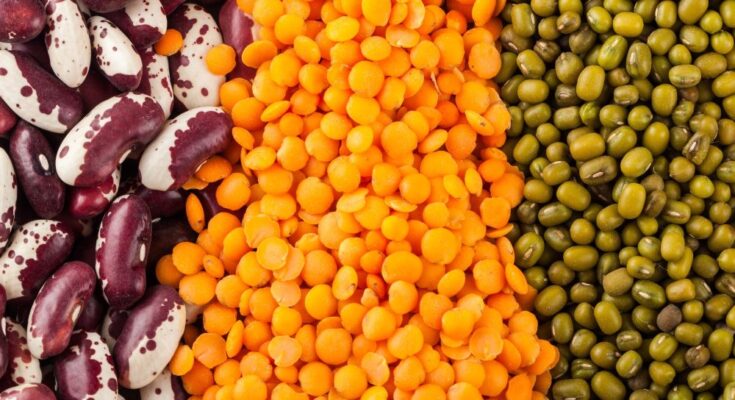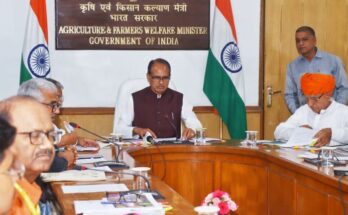India Pulses and Grains Association (IPGA) co-hosted a webinar on chickpeas and lentils in association with Pulse Australia and Austrade under ‘The IPGA Knowledge Series’. IPGA organised the webinar as a part of the Australian Government’s Australia India Business Exchange (AIBX) programme.
The Indian overview on lentils was presented by Anurag Tulshan, Managing Director – Esarco Exim and IPGA – East Zone convener and Australian overview by Nick Poutney, Director – Pulse Australia. The overview on Indian chickpeas was presented by Nirav Desai, Managing Partner – GGN Research and Australian overview by Peter Wilson, Managing Director, Wilson International Trade. The webinar was attended by around 600 participants from across the world with majority being from India and Australia.
Saurabh Bhartia, Senior Trader, Viterra India, IPGA and GPC Executive Committee member set the tone for the webinar in his opening remarks saying, “The share of Australian lentils in India’s import has been 10-15 percent over the last seven-eight years and almost 80-90 percent of its chickpeas’ requirements came from Australia till December 2017. However, the 66 percent import duty imposed by Government of India has made it difficult to import from Australia resulting in these imports dropping to almost zero. In 2021, all pulses in India are trading above minimum support price and government stocks have hit a low. Both show we definitely have issues in our production of pulses in the last Kharif and Rabi seasons.”
Anurag Tulshan, Managing Director, Esarco Exim and IPGA’s East Zone convener giving an overview on India’s lentils scenario said, “The current supply and demand situation is tight. The government needs to come forward and make some changes with regard to the duty structure, so as to get in more cargo because going forward, from the month of July until December 2021, we are going to need to import at least 500,000 tonnes of lentils.”
Tulshan, in his presentation, highlighted the following key points
- This year, Indian government estimates around 1.35 million tonnes of lentils production, but as per trade estimates, that should not be more than 900,000 to a million tonnes. The crop size has been lower this year and current prices are witness to it.
- The total consumption of lentils in our country is approximately 1.80 to 2 million tonnes a year, which translates to roughly 150,000-170,000 tonnes every month. So, we are definitely dependent on imports of lentils.
- India currently has an inventory of approximately 350,000 – 400,000 tonnes of red lentils which includes around 200,000 tonnes of imported red lentils while we have approximately 150,000-200,000 tonnes of Indian desi red lentils. This should last for two and a half months after which we need to import more.
- Major chunk of Australia’s last year’s production of around 700,000 tonnes has already been exported and not much is left. However, Australian supply of lentils is definitely anticipated to be lower compared to last year.
Nick Poutney, Director, Pulse Australia presenting an overview on Australian lentils scenario said that while the Indian government might be over-estimating India’s lentils production, the Australian government may be underestimating the Australian lentils production.
Poutney, in his presentation, highlighted the following key points
- Indian government might be estimating 1.20 to 1.30 million tonnes of lentils production as opposed to the trade estimates of around 900,000 metric tonnes to a 1.00 million tonnes.
- Most industry estimates consider the 2020-21 Australian lentils crop at 800,000 metric tonnes or higher. (ABARES at 634,000 MT).
- With steady to slightly higher acreage planted but with a reversion back to average yields, the 2021-22 crop should achieve 500,000 MT.
- Based on recent years, Bangladesh is a consistent buyer with demand exceeding 250,000 MT. Sri Lankan demand has increased to over 100,000 MT. The balance will export to Egypt, Pakistan, and the UAE.
- If Australia produces a 500,000 MT lentil crop in 2021-22 then it will be relatively easy to export with limited demand from India.
- If India decides to reduce import duties on lentils to allow imports, this will place pressure on relatively tighter Australian supplies.
Nirav Desai, Managing Partner, GGN Research giving an overview of India’s chickpeas scenario said, “The overall chickpeas production in India has been below average majorly due to poor yields in Madhya Pradesh and Rajasthan. Gujarat is the only state that has had higher production. But Gujarat has relatively less acres under chickpeas production, just 800,000 compared to bigger states like Madhya Pradesh and Rajasthan.”
Desai, further, highlighted the following key points in his presentation
- Till April 14, 2021, NAFED (National Agricultural Cooperative Marketing Federation of India) had procured about 248,000 tonnes of chickpeas, whereas the target was about more than 2.7 million tonnes. This year NAFED does not have a lot of stock hence, we do not see NAFED intervening in the market repeatedly.
- We are going to be broadly dependent on the market supplies which are expected to be lower by 12-15 percent over last year.
- This year chana (chickpea) prices are likely remain firm and substantial uptrend on tight supplies. However, only major setback can come from the government if they make changes in the import duty.
Peter Wilson, Managing Director, Wilson International Trading giving an overview of Australia’s chickpeas scenario said, “I applaud the dialogue that continues between Australia, Pulse Australia, and India to ensure that we are there as policies evolve and create an environment conducive to trade. In Australia, we grow desi chickpeas on deep subsoil moisture. The very good moisture levels that we have had in Northern Australia for the last few months have given us ideal seeding conditions for crops in the northern north-eastern cropping zone. So, we don’t share the same issues that are currently facing lentil producers in Southern Australia.”
Wilson, in his presentation, highlighted the following key factors
- The Australian desi chickpeas market has rallied by about $40 – $50 per tonne since February this year and is sitting close around $700 which is which is pretty good money in terms of returns for Australian farmers. In 2021, we can certainly anticipate an increase in area as well as some recovery in yield.
- Australia harvested 800,000 tonne of crop last year and the prices have given the farmers confidence to go back and increase the sowing area.
- We’ve seen significant demand from Pakistan with Bangladesh and Nepal also vying for significant volumes. As we see decent market access for Australian desi chickpeas and a market that is moving higher, it is giving farmers significant confidence for 2021-22. If Iran also moves back into the direct import business, the market will truly open up.
- In Australia this year, we have the moisture conditions to support a pretty good chickpea crop outcome starting from September – October. So if in fact, the Indian policymakers do change their policies, Australia will be ready with a reasonable crop time to meet India’s import demands.




